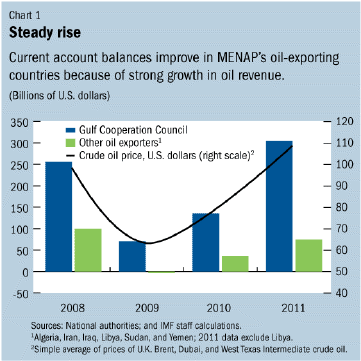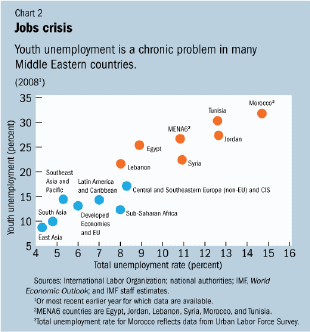Press Release: IMF Sees Long-Term Opportunities for the Middle East and North Africa Despite Short-Term Challenges Amid Unrest
April 27, 2011
April 27, 2011
Changes taking place in the Middle East and North Africa provide an opportunity for the region to lay the foundation for a socially inclusive and more dynamic growth model, but in the near term, countries face multiple pressures stemming from higher commodity prices and disruptions to economic activity, the IMF said in its April 2011 Regional Economic Outlook for the Middle East, North Africa, Afghanistan and Pakistan (MENAP), released today.
“In the long run, the uprisings could give a boost to the economies in the region by setting a more inclusive growth agenda, improving governance, and providing greater and more equal opportunity for its young and growing population. However, the near-term outlook is challenging, and there is a pressing need to address unemployment and improve social safety nets,” Masood Ahmed, Director of the IMF’s Middle East and Central Asia Department, said at the launch conference of the report in Dubai. “The immediate challenge facing oil-importing countries in the Middle East is to maintain social cohesion and macroeconomic stability in the face of multiple pressures,” he added.
Mixed short-term outlook
The report projects overall growth in the MENAP region at 3.9 percent. But within that picture, the economies of the oil-exporting countries—Algeria, Bahrain, Iran, Iraq, Kuwait, Oman, Qatar, Saudi Arabia, Sudan, the United Arab Emirates, and Yemen—are expected to expand by 4.9 percent (projections exclude Libya), owing largely to higher oil prices and oil production. Oil importers—Afghanistan, Djibouti, Egypt, Jordan, Lebanon, Mauritania, Morocco, Pakistan, Syria, and Tunisia—are set to grow a mere 2.3 percent. Two major factors are driving the current scenario: the unrest in the region and ensuing uncertainty, and the surge in global fuel and food prices.
Windfall for oil exporters…
With higher oil prices and increased oil production, the combined external current account balance for regional oil exporters is expected to more than double to $380 billion in 2011 (excluding Libya) (see Chart 1). Overall, these economies are set to expand, with overall real GDP (excluding Libya) projected to grow by 4.9 percent in 2011. While for the group as a whole, non-oil GDP growth is projected to remain flat at 3.5 percent, in the GCC, increased spending will result in an increase in non-oil GDP growth to 5.3 percent in 2011, from 4.2 percent in 2010. Despite the higher spending, fiscal positions will improve, with higher oil revenues more than offsetting additional public expenditure. Notwithstanding this overall positive outlook, the region’s oil exporters continue to face challenging structural issues, such as the need for greater diversification of their economies, job creation for their populations, further financial development to support economic growth, and improvements in the management of public resources.

…but challenges for oil importers
Oil importers face a difficult economic year as they manage both internal and external pressures. The deterioration in the terms of trade resulting from higher food and fuel prices is expected to inflate their import bill by about $15 billion, or nearly 3 percent of GDP on average, the IMF outlook says. This will, in turn, translate into either higher inflation or a worsened fiscal balance, depending on the extent of subsidies.
For many oil importers, political turmoil is expected to weigh on tourism and investment, which—together with higher funding costs and pressures for higher spending across the region—will add to fiscal pressures. Pressures on macroeconomic and financial stability—if not addressed quickly—could impede the pursuit of a new socially inclusive growth agenda and hamper job creation. To this end, governments that are faced with limited fiscal space will need to consider partially offsetting some of the additional spending in priority areas through cuts elsewhere.
“Additional spending in the near term is understandable and necessary to ensure social cohesion, but will add to the strain on public finances. Many countries will need external support to help them manage the transition,” Mr. Ahmed noted. However, in the medium term, policies to alleviate social tensions cannot be perpetually financed through deficits, and will require measures to raise revenues, well targeted social safety nets to replace generalized subsidies in order to benefit the poor more effectively, and actions to reduce waste in public spending.
Not enough job creation
Throughout the region, the slow growth equilibrium of the past years did not generate enough jobs for the growing labor force. Moreover, the report noted that there has been an increasing sense that the business environment was skewed to benefit a privileged few. Going forward, much remains to be done to boost job creation and enhance employability of young people in a region where youth unemployment rates register well above 20 percent in a number of countries (see Chart 2).

“In the short term, policymakers should focus on bringing forward labor-intensive infrastructure investments, provide tax incentives to small- and medium-sized enterprises, and introduce well-designed training programs. But these measures are no substitute for a comprehensive employment strategy that reorients education to better equip graduates with the skills that employers seek; improves the business climate; and dismantles labor market rigidities that discourage firms from hiring,” Mr. Ahmed said.
Common goals
The report said that each country will need to find its own homegrown path for development, but all will need to respond to some common goals, including a stable macroeconomic environment to provide confidence and attract investment; enough private sector jobs to absorb the currently unemployed and a fast-growing labor force; access to economic opportunity for citizens to realize their potential; social protection for the vulnerable; and strong and transparent institutions that ensure accountability and good governance.
The report noted further that the region has many strengths: a dynamic and young population, vast natural resources, a large regional market, an advantageous geographic position, and access to key markets. “While the months ahead will be challenging and inevitably marked by setbacks, there is now momentum for change to build upon,” Mr. Ahmed concluded.
| Selected Economic Indicators | |||||||
| Middle East, North Africa, Afghanistan, and Pakistan (MENAP) | |||||||
| Average | Proj. | ||||||
| 2000–05 | 2006 | 2007 | 2008 | 2009 | 2010 | 2011 | |
|
Real GDP Growth |
|||||||
|
(Annual change; percent) |
|||||||
|
MENAP1 |
5.2 | 5.9 | 6.1 | 4.7 | 2.1 | 3.9 | 3.9 |
|
Oil Exporters1 |
5.6 | 5.7 | 6.2 | 4.7 | 0.7 | 3.5 | 4.9 |
|
of Which: GCC |
5.5 | 5.9 | 5.8 | 7.2 | 0.2 | 5.0 | 7.8 |
|
Oil Importers |
4.4 | 6.3 | 6.1 | 4.8 | 4.7 | 4.7 | 2.3 |
|
General Government Fiscal Balance |
|
|
|
|
| ||
|
(Percent of GDP) |
|||||||
|
MENAP1 |
2.3 | 7.1 | 5.2 | 6.7 | -3.6 | -0.2 | 2.4 |
|
Oil Exporters1 |
5.8 | 13.2 | 10.3 | 12.9 | -2.7 | 3.0 | 7.5 |
|
of Which: GCC |
9.3 | 22.4 | 17.5 | 24.7 | -0.8 | 7.2 | 12.6 |
|
Oil Importers |
-5.3 | -4.7 | -4.8 | -5.4 | -5.2 | -6.0 | -6.8 |
|
Current Account Balance |
|
|
|
|
|
| |
|
(Percent of GDP) |
|||||||
|
MENAP1 |
7.9 | 16.2 | 13.0 | 13.3 | 1.7 | 5.9 | 11.7 |
|
Oil Exporters1 |
11.2 | 21.9 | 17.9 | 18.8 | 4.2 | 9.2 | 16.9 |
|
of Which: GCC |
13.4 | 25.4 | 19.6 | 22.5 | 7.6 | 12.5 | 21.7 |
|
Oil Importers |
-0.4 | -1.6 | -2.5 | -4.6 | -4.6 | -3.3 | -4.1 |
|
|
|||||||
|
Sources: National authorities; and IMF staff estimates and projections. | |||||||
|
12011 data exclude Libya. | |||||||
| ||||||||||||||||||||||||||||||||||||||||||||||||||||||||||||||||||||||||||||||||||||||||||||||||||||||||||||||||||||||||||||||||||||||||||||||||||||||||||||||||||||||||||||||||||||||||||||||||||||||||||||||||||||||||||||||||||||||||||||||||||||||||||||||||||||||||||||||||||||||||||||||||
IMF EXTERNAL RELATIONS DEPARTMENT
| Public Affairs | Media Relations | |||
|---|---|---|---|---|
| E-mail: | publicaffairs@imf.org | E-mail: | media@imf.org | |
| Fax: | 202-623-6220 | Phone: | 202-623-7100 | |


